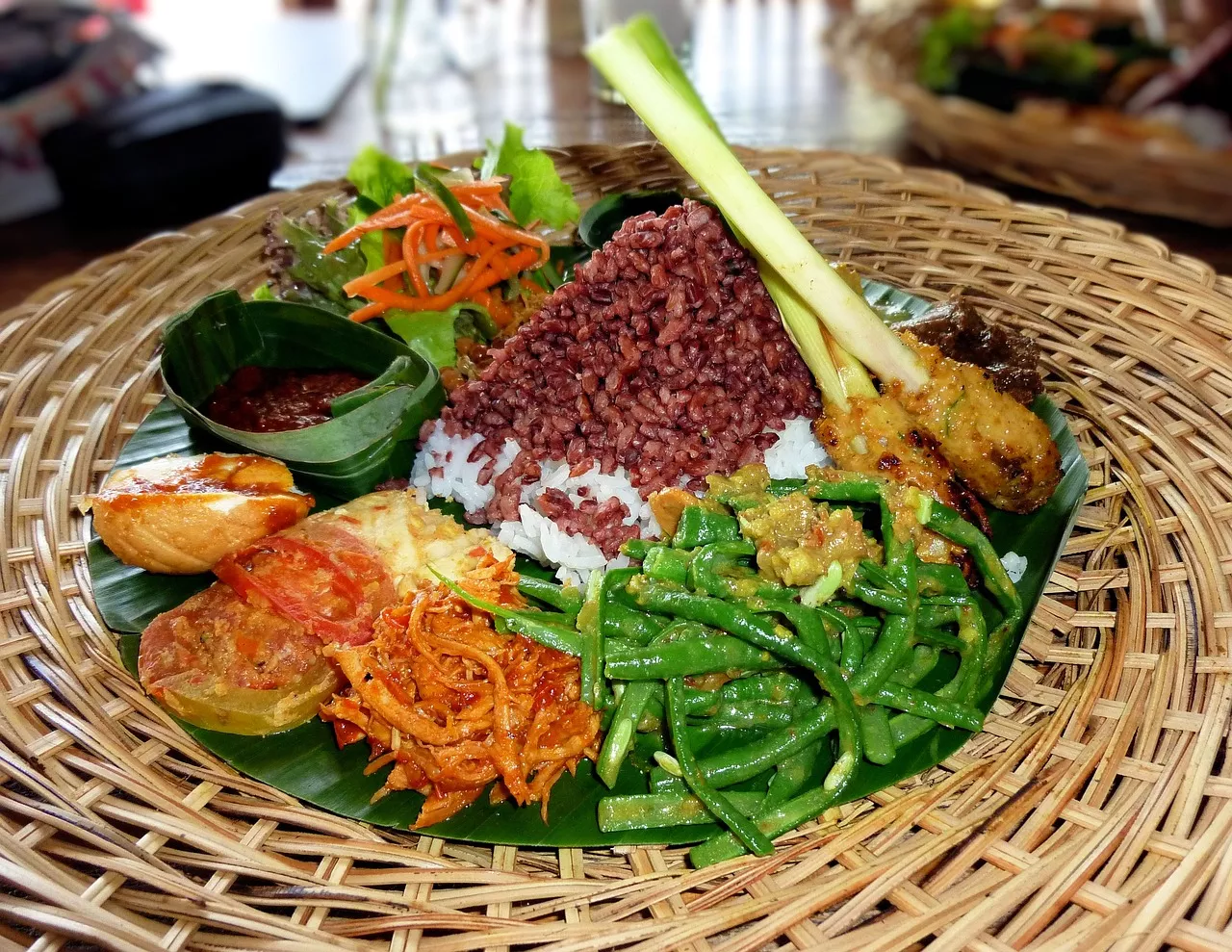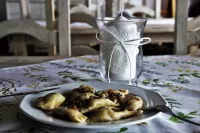The Influence of Indonesian Culture on its Cuisine
Indonesian cuisine is a symphony of flavors, blending influences from China, India, the Middle East, and the Netherlands. The country's diverse cultural heritage has shaped its culinary traditions, resulting in a unique and tantalizing culinary experience. Indonesian cuisine is a true reflection of the country's history, trade routes, and multicultural society.
1: The roots of Indonesian cuisine can be traced back to the early maritime trade routes that connected the Indonesian archipelago with the rest of the world. These trade routes brought spices, ingredients, and cooking techniques from different regions, creating a melting pot of flavors. The Chinese introduced soy sauce and stir-frying techniques, while Indian traders brought spices like turmeric, cumin, and coriander. The Middle Eastern influence is evident in dishes like nasi kebuli, a fragrant rice dish cooked with aromatic spices and meat. The Dutch colonial rule also left its mark on Indonesian cuisine, introducing ingredients like potatoes, carrots, and tomatoes.
2: Indonesian cuisine is deeply rooted in its cultural traditions. Food plays a central role in Indonesian society, and meals are often enjoyed as communal events. The art of cooking and sharing meals is passed down through generations, with each family having their own traditional recipes and cooking methods. Indonesians take great pride in their culinary heritage, and every dish is prepared with love and care. The use of fresh ingredients, local produce, and traditional cooking techniques ensures that the flavors are authentic and true to their roots.
3: The diversity of Indonesia's culture is reflected in its cuisine. Each region has its own unique culinary traditions and specialties. From the spicy and flavorful dishes of Sumatra to the aromatic and coconut-based cuisine of Bali, every bite tells a story. The rich cultural tapestry of Indonesia is showcased through its food, and exploring the country's cuisine is like embarking on a culinary adventure through different traditions and flavors.
Key Ingredients in Indonesian Cooking
One cannot delve into Indonesian cuisine without exploring the incredible array of spices that bring these dishes to life. The use of spices is integral to Indonesian cooking, adding depth, aroma, and complexity to the dishes.
1: Lemongrass is one of the key ingredients in Indonesian cooking, adding a citrusy and refreshing flavor to many dishes. It is often used in curries, soups, and stir-fries, infusing the dish with its unique aroma. Another essential spice is galangal, a rhizome similar to ginger but with a more pungent and peppery flavor. Galangal is commonly used in soups and stews, imparting a distinct taste to the dish.
2: Chili peppers are a staple in Indonesian cuisine, adding heat and spice to many dishes. From mild to fiery, chili peppers come in various forms and are used in both fresh and dried forms. The iconic sambal, a spicy chili sauce, is a must-have accompaniment to Indonesian meals. Along with chili peppers, other spices like turmeric, coriander, and cumin are used to create flavorful spice pastes that form the base of many Indonesian dishes.
3: Coconut is another essential ingredient in Indonesian cooking. It is used in various forms, including coconut milk, grated coconut, and coconut oil. Coconut milk is widely used in curries and soups, adding a creamy and rich texture to the dishes. Grated coconut is used in desserts and snacks, while coconut oil is commonly used for frying and stir-frying. The use of coconut gives Indonesian cuisine its distinct tropical flavor profile.
Traditional Indonesian Dishes
Indonesian cuisine boasts a wide array of traditional dishes, each with its own unique flavors and cooking techniques. These dishes are a testament to the rich culinary heritage of the country.
1: Rendang is arguably one of Indonesia's most famous dishes. Originating from the Minangkabau culture of West Sumatra, rendang is a slow-cooked beef curry bursting with aromatic spices. The meat is cooked for hours until it becomes tender and infused with the flavors of the spices. Rendang is known for its rich, complex flavors and is often served during special occasions and celebrations.
2: Nasi goreng, or fried rice, is another iconic Indonesian dish that has gained international popularity. It is made by stir-frying cooked rice with a variety of ingredients such as shrimp, chicken, vegetables, and spices. The dish is typically garnished with a fried egg, crispy shallots, and a side of sambal. Nasi goreng is a versatile dish that can be enjoyed for breakfast, lunch, or dinner, and it is a staple in Indonesian households.
3: Gado-gado is a traditional Indonesian salad that showcases the country's love for fresh vegetables and peanut sauce. It is made with a combination of blanched or steamed vegetables such as cabbage, bean sprouts, and carrots, topped with a rich and creamy peanut sauce. Gado-gado is a popular street food dish and is often served with a side of emping, a type of Indonesian crackers.
Regional Variations in Indonesian Cuisine
Indonesia's vast archipelago is home to diverse culinary traditions, with each region having its own unique flavors and specialties.
1: The cuisine of Sumatra, the largest island in Indonesia, is known for its bold and spicy flavors. Sumatran dishes often feature ingredients like chili peppers, garlic, ginger, and coconut milk. Beef rendang, sambal balado (a chili sauce), and gulai (a spicy curry) are some of the iconic dishes from this region. The flavors of Sumatran cuisine are influenced by the Minangkabau, Batak, and Acehnese cultures.
2: Java, the cultural and political center of Indonesia, has its own distinct culinary traditions. Javanese cuisine is characterized by its mild flavors and the use of sweet soy sauce (kecap manis). Some popular Javanese dishes include soto ayam (chicken soup), gudeg (young jackfruit stew), and tumpeng (cone-shaped rice dish). Java is also known for its traditional snacks and desserts, such as tempeh, bakso (meatball soup), and klepon (glutinous rice balls filled with palm sugar).
3: Bali, the famous island paradise, is not only known for its stunning beaches but also for its unique cuisine. Balinese food is characterized by its use of local spices, fresh seafood, and aromatic herbs. Babi guling (roast suckling pig), sate lilit (minced meat skewers), and lawar (a mixed vegetable salad) are some of the traditional dishes from Bali. The flavors of Balinese cuisine are influenced by Hindu traditions and the island's natural resources.
Popular Indonesian Street Food
Indonesia is a haven for street food lovers, offering a wide variety of delicious and affordable dishes that can be found in bustling food stalls and markets.
1: Satay is one of the most beloved street foods in Indonesia. It consists of skewered and grilled meat, usually chicken or beef, served with a flavorful peanut sauce. Each region in Indonesia has its own variation of satay, with different marinades and dipping sauces. Satay is often enjoyed as a snack or as a main course, accompanied by rice cakes and fresh vegetables.
2: Martabak is a popular Indonesian street food that can be found throughout the country. It is a type of stuffed pancake that comes in two versions: sweet and savory. Sweet martabak is filled with chocolate, cheese, or a combination of both, while savory martabak is filled with minced meat, vegetables, and eggs. Martabak is typically cooked on a griddle and served hot, making it a favorite late-night snack.
3: Siomay is a steamed dumpling filled with a mixture of fish, shrimp, and vegetables. It is often served with a peanut sauce and is a popular street food dish in Jakarta. Siomay is a light and refreshing snack that is perfect for hot and humid days. It can be enjoyed as a quick bite on the go or as part of a larger meal.
Indonesian Culinary Traditions and Customs
Indonesian cuisine is not just about the flavors and ingredients but also about the traditions and customs that surround food preparation and consumption.
1: In Indonesian culture, meals are often enjoyed as communal events, bringing family and friends together. It is common for dishes to be placed in the center of the table, and everyone helps themselves. Sharing food is a way of showing hospitality and fostering a sense of togetherness. Indonesian meals are often accompanied by a variety of condiments and sambals, allowing each person to customize their plate according to their taste preferences.
2: Indonesian cuisine is deeply rooted in the belief of balance and harmony. Traditional Indonesian meals often consist of a combination of flavors, textures, and colors. A typical meal will include a main dish, rice or noodles, vegetables, and a side of sambal or condiments. The balance of sweet, sour, salty, and spicy flavors is key to creating a harmonious meal.
3: Indonesians also have specific customs and etiquette when it comes to dining. It is considered impolite to start eating before the eldest person at the table begins. It is also customary to use the right hand for eating, as the left hand is considered unclean. Indonesians believe that food should be enjoyed slowly and savored, and rushing through a meal is seen as disrespectful.
Indonesian Culinary Tourism and Food Festivals
Indonesia's rich culinary heritage has become a major attraction for food enthusiasts from around the world. Culinary tourism is on the rise, with travelers seeking to explore the country's diverse flavors and culinary traditions.
1: Many cities in Indonesia host food festivals and culinary events that showcase the best of Indonesian cuisine. These festivals bring together food vendors, chefs, and food enthusiasts, creating a vibrant atmosphere filled with the aroma of spices and the sizzle of street food. Some of the popular food festivals in Indonesia include the Ubud Food Festival in Bali, the Jakarta Culinary Feastival, and the Yogyakarta Food Festival.
2: Culinary tours and cooking classes have also gained popularity among tourists visiting Indonesia. These tours allow visitors to immerse themselves in the local food scene, exploring traditional markets, trying street food, and learning how to cook Indonesian dishes. Cooking classes are a great way to learn about the ingredients, techniques, and flavors of Indonesian cuisine while interacting with local chefs and home cooks.
3: Indonesian cuisine has also made its mark on the international culinary scene. Indonesian restaurants can now be found in major cities around the world, offering a taste of the country's vibrant flavors and unique dishes. Chefs and food enthusiasts are increasingly experimenting with Indonesian ingredients and techniques, creating fusion dishes that blend traditional Indonesian flavors with modern culinary trends.
Indonesian Fusion Cuisine: Modern Twists on Traditional Dishes
As Indonesian cuisine gains global recognition, chefs and food enthusiasts are putting their own creative spin on traditional dishes, resulting in innovative and exciting fusion cuisine.
1: Indonesian fusion cuisine combines traditional Indonesian flavors with modern culinary techniques and ingredients. Chefs are blending local ingredients with international flavors, creating dishes that push the boundaries of traditional Indonesian cuisine. For example, Indonesian-style tacos combine the flavors of Indonesian spices with the concept of Mexican street food, resulting in a unique and flavorful dish.
2: The use of traditional Indonesian ingredients in non-traditional ways is also a hallmark of Indonesian fusion cuisine. For instance, tempeh, a traditional Indonesian soy product, is being used as a meat substitute in vegetarian and vegan dishes around the world. Chefs are also incorporating Indonesian spices and flavors into dishes like pasta, burgers, and sandwiches, giving them a distinct Indonesian twist.
3: The rise of social media and food blogging has also contributed to the popularity of Indonesian fusion cuisine. Food enthusiasts are sharing their creative recipes and experiences on platforms like Instagram and YouTube, inspiring others to experiment with Indonesian flavors in their own kitchens. Indonesian fusion cuisine is not only about creating new dishes but also about celebrating the rich flavors and culinary traditions of Indonesia.
Exploring the Rich Flavors of Indonesian Cuisine
Embarking on a culinary journey through Indonesian cuisine is like taking a voyage through the country's history, culture, and traditions. From the aromatic spices to the vibrant colors and bold flavors, Indonesian cuisine is a celebration of the country's rich culinary heritage.
Whether you're savoring a bowl of spicy beef rendang, indulging in a plate of fragrant nasi goreng, or sampling the myriad street food delights, each bite tells a story of Indonesia's diverse cultural tapestry. The culinary traditions, customs, and fusion creations all contribute to the unique and captivating world of Indonesian cuisine.
So, grab your chopsticks or fork and get ready to embark on a sensory adventure through the enchanting flavors of Indonesian cuisine. From the bustling street food stalls of Jakarta to the elegant restaurants of Bali, the flavors of Indonesia await, ready to tantalize your taste buds and leave you craving for more.

 Start the New Year Right with These Delicious Gluten-Free Recipes
Start the New Year Right with These Delicious Gluten-Free Recipes Polish Cuisine the Unique Ingredients and Dishes of Poland
Polish Cuisine the Unique Ingredients and Dishes of Poland



